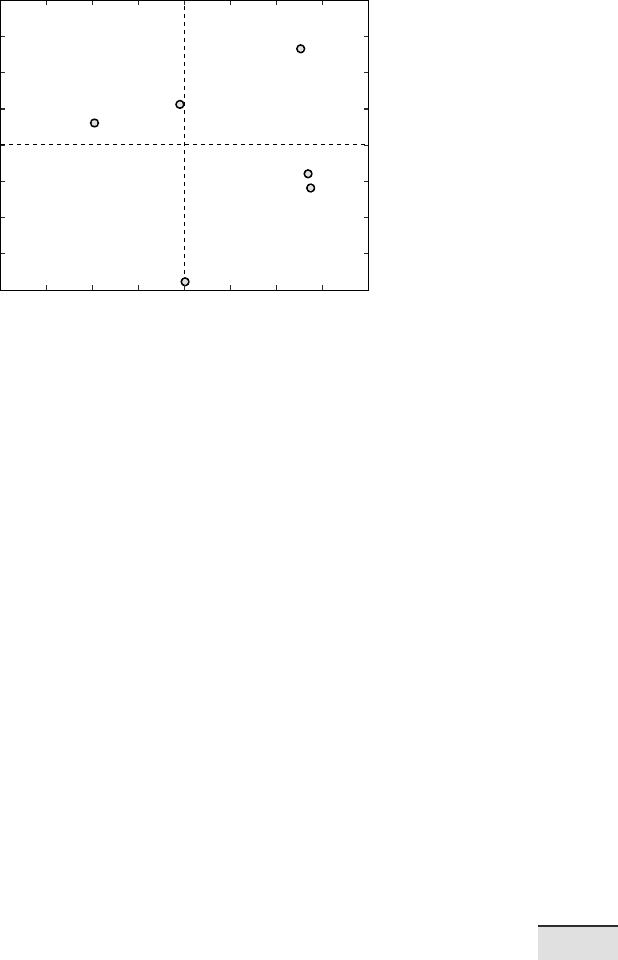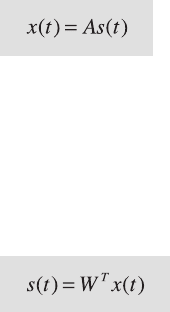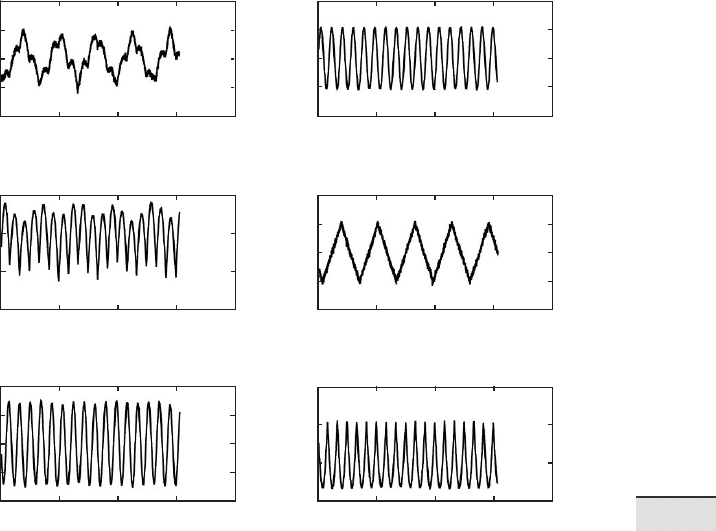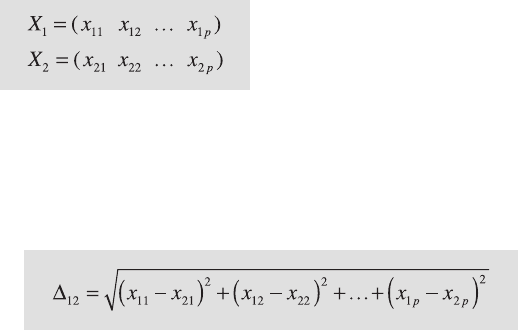Trauth M.H., MATLAB® Recipes for Earth Sciences, Third edition
Подождите немного. Документ загружается.

298 9 MULTIVARIATE STATISTICS
load of B1. Again, the high in uence of B2 with an opposite sign re ects the
weathering of B1 to produce B2. e occurrence of B3 in both source rocks
results in high loads of B3 in both PC
1
and PC
2
. Principle components PC
3
and PC
4
show mixed and contradictory patterns of loads and are therefore
not easy to interpret, most probably as a result of noise in the data set.
An alternative way to plot of the loads is as a bivariate plot of two princi-
pal components. We therefore ignore PC
3
and PC
4
at this point and concen-
trate on PC
1
and PC
2
. Remember to either close the gure window before
plotting the loads or clear the gure window using
clf, in order to avoid
integrating the new plot as a fourth subplot in the previous gure window.
plot(pcs(:,1),pcs(:,2),'o'), hold on
text(pcs(:,1)+0.02,pcs(:,2),minerals,'FontSize',14)
plot([-0.8 0.8],[0 0],'r')
plot([0 0],[-0.8 0.8],'r')
xlabel('First Principal Component Loads')
ylabel('Second Principal Component Loads')
hold off
We can now observe in a single plot the same relationships that were previ-
ously shown on several graphs (Fig. 9.3). It is also possible to plot the data
set as functions of the new variables. is requires the second output of
princomp, containing the principal component scores.
plot(newdata(:,1),newdata(:,2),'+'), hold on
text(newdata(:,1)+0.01,newdata(:,2),sample)
plot([-80 100],[0 0],'r')
plot([0 0],[-60 80],'r')
xlabel('First Principal Component Scores')
ylabel('Second Principal Component Scores')
hold off
is plot clearly de nes groups of samples with similar in uences. Samples
5, 8, 20, 27 and 30, dominated by in uences of the rst source rock, all clus-
ter in the right half of the diagram, while samples 7, 9, 24 and once again 30,
strongly in uenced by the second rock type, all fall in the upper half of the
graph. Next, we use the third output of the function
princomp to compute
the variances of the PCs.
percent_explained = 100*variances/sum(variances)
percent_explained =
72.7390
14.6658
4.3129
4.1775
2.7791
1.3257

9.2 PRINCIPAL COMPONENT ANALYSIS 299
9 MULTIVARIATE STATISTICS
MinA1
MinA2
MinA3
MinB1
MinB2
MinB3
−0.6 −0.4
−0.2
0
0.2 0.4 0.6 0.8
−0.8
−0.8
−0.6
−0.4
−0.2
0.4
0.2
0.6
0.8
0
First Principal Component Loads
Second Principal Component Loads
Fig. 9.3 Principal components suggesting that the PCs are in uenced by di erent minerals.
See text for detailed interpretation of the PCs.
We see that almost 73 % of the total variance is contained in PC
1
, and around
15 % is contained in PC
2
, while none of the other PCs contribute very much
to the total variance of the data set. is means that most of the variability
in the data set can be described by just two new variables. As would be ex-
pected, the two new variables do not correlate with each other as illustrated
by a correlation coe cient between
newdata(:,1) and newdata(:,2)
that is close to zero.
corrcoef(newdata(:,1),newdata(:,2))
ans =
1.0000 0.0000
0.0000 1.0000
We can therefore plot the time series of the thirty samples as two indepen-
dent variables PC
1
and PC
2
, in a single plot.
plot(1:30,newdata(:,1),1:30,newdata(:,2)), grid,
legend('PC1','PC2')
xlabel('Sample ID'), ylabel('Value')
is plot displays ca. 73 %+15 %=88 % of the variance contained in the mul-
tivariate data set. According to our interpretation of PC
1
and PC
2
this plot
shows the variability in the relative contributions from the two sources to
the sedimentary column under investigation.
In summary, the approach described above has been used to study the

300 9 MULTIVARIATE STATISTICS
provenance of varved lake sediments deposited around 33 kyrs ago in a
landslide-dammed lake in the Quebrada de Cafayate (Trauth et al. 2003).
e provenance of the sediments contained in the varved layers can be
traced using index minerals characteristic of the various possible watershed
source areas. A comparison of the mineral assemblages in the sediments
with those of potential source rocks within the catchment area indicates
that Fe-rich Tertiary sedimentary rocks exposed in the Santa Maria Basin
were the source of the red-colored basal portion of the varves. In contrast,
metamorphic rocks in the mountainous parts of the catchment area were
the most likely source of the relatively drab-colored upper part of the varves
(see also Section 8.7).
9.3 Independent Component Analysis (by N. Marwan)
Principal component analysis (PCA) is the standard method for separating
mixed signals. Such analyses produce signals that are linearly uncorrelated.
is method is also called whitening since this property is characteristic of
white noise. Although the separated signals are uncorrelated, they can still
be interdependent, i.e., nonlinear correlation may still remain. e inde-
pendent component analysis (ICA) was developed to investigate such data.
It separates mixed signals into independent signals, which are then non-
linearly uncorrelated. Fast ICA algorithms use a criterion that estimates
how Gaussian the combined distribution of the independent components is.
e less Gaussian this distribution is, the more independent the individual
components are.
According to the model, n independent signals x(t) are linearly mixed
in m measurements,
in which we are interested in the source signals s
i
and the mixing matrix A.
For example, we can imagine that we are at a party in which a lot of people
are carrying on independent conversations. We can hear a mixture of these
conversations but perhaps cannot distinguish them individually. We could
install some microphones and use these to separate out the individual con-
versations: hence, this dilemma is sometimes known as the cocktail party
problem. Its correct term is blind source separation, which is de ned by

9.3 INDEPENDENT COMPONENT ANALYSIS (BY N. MARWAN) 301
9 MULTIVARIATE STATISTICS
where W
T
is the separation matrix required to reverse the mixing and ob-
tain the original signals. Let us consider a mixing of three signals, s
1
, s
2
and
s
3
, and their separation using PCA and ICA. First, we create three periodic
signals
clear
i = (1:0.01:10 * pi)';
[dummy index] = sort(sin(i));
s1(index,1) = i/31; s1 = s1 - mean(s1);
s2 = abs(cos(1.89*i)); s2 = s2 - mean(s2);
s3 = sin(3.43*i);
subplot(3,2,1), plot(s1), ylabel('s_1'), title('Raw signals')
subplot(3,2,3), plot(s2), ylabel('s_2')
subplot(3,2,5), plot(s3), ylabel('s_3')
Now we mix these signals and add some observational noise. We obtain a
three-column vector
x which corresponds to our measurements (Fig. 9.4).
randn('state',1);
x = [.1*s1 + .8*s2 + .01*randn(length(i),1), ...
.4*s1 + .3*s2 + .01*randn(length(i),1), ...
.1*s1 + s3 + .02*randn(length(i),1)];
subplot(3,2,2), plot(x(:,1)), ylabel('x_1'), title('Mixed
signals')
subplot(3,2,4), plot(x(:,2)), ylabel('x_2')
subplot(3,2,6), plot(x(:,3)), ylabel('x_3')
We begin with the separation of the signals using PCA. We calculate the
principal components and the whitening matrix
W_PCA with
[E sPCA D] = princomp(x);
sPCA = sPCA./repmat(std(sPCA),length(sPCA),1);
e PC scores sPCA are the linearly separated components of the mixed
signals x (Fig. 9.5).
subplot(3,2,1), plot(sPCA(:,1))
ylabel('s_{PCA1}'), title('Separated signals - PCA')
subplot(3,2,3), plot(sPCA(:,2)), ylabel('s_{PCA2}')
subplot(3,2,5), plot(sPCA(:,3)), ylabel('s_{PCA3}')
e mixing matrix A can be found with
A_PCA = E * sqrt(diag(D));
W_PCA = inv(sqrt(diag(D))) * E';

302 9 MULTIVARIATE STATISTICS
0 1000 2000 3000 4000
1000
1000
2000
2000
3000
3000
4000
4000
0 1000 2000 3000 4000
0 1000 2000 3000 4000
0 1000 2000 3000 4000
0
0
−2
−1
0
1
2
−0.4
−0.2
0
0.2
0.4
−1.0
−0.5
0
0.5
−1.0
−0.5
0
0.5
1.0
−1.0
−0.5
0
0.5
−0.5
0
0.5
x
1
x
2
x
3
s
1
s
2
s
3
Raw Signals Mixed Signals
a
c
e f
d
b
Fig. 9.4 Sample input for the independent component analysis. We rst generate three
period signals (a, c, e), mix the signals and add some Gausssian noise (b, d, f).
Next, we separate the signals into independent components. We will do
this by using a FastICA algorithm, which is based on a xed-point iteration
scheme, to nd the least Gaussian distributed of the independent compo-
nents W
T
x. For the nonlinearity function we use a power of three function,
as an example,
rand('state',1);
div = 0;
B = orth(rand(3, 3) - .5);
BOld = zeros(size(B));
while (1 - div) > eps
B = B * real(inv(B' * B)^(1/2));
div = min(abs(diag(B' * BOld)));
BOld = B;

9.3 INDEPENDENT COMPONENT ANALYSIS (BY N. MARWAN) 303
9 MULTIVARIATE STATISTICS
0 1000 2000 3000 4000
1000
1000
2000
2000
3000
3000
4000
4000
0 1000 2000 3000 4000
0 1000 2000 3000 4000
0 1000 2000 3000 4000
0
0
−4
−2
0
2
4
−4
−2
0
2
−2
−1
0
1
2
−4
−2
0
2
4
−4
−2
0
2
4
−2
0
2
4
sss
PCA1PCA2PCA3
s
ICA1
s
ICA2
s
ICA3
Separated Signals − PCA
Separated Signals − ICA
a
c
e f
d
b
Fig. 9.5 Output of the principal component analysis (a, c, e) compared with the output of
the independent component analysis (b, d, f). e PCA has not reliably separated the mixed
signals, whereas the ICA identi ed the source signals almost perfectly.
B = (sPCA' * (sPCA * B) .^ 3) / length(sPCA) - 3 * B;
sICA = sPCA * B;
end
We plot the separated components (Fig. 9.5) with
subplot(3,2,2), plot(sICA(:,1)), ylabel('s_{ICA1}'),
title('Separated signals - ICA')
subplot(3,2,4), plot(sICA(:,2)), ylabel('s_{ICA2}')
subplot(3,2,6), plot(sICA(:,3)), ylabel('s_{ICA3}')
We can now see that the PCA algorithm has not provided a satisfactory
separation of the mixed signals. e saw-tooth signal, in particular, was not
correctly identi ed. In contrast, the ICA has identi ed the source signals
almost perfectly. e only noticeable di erences are the noise level, which

304 9 MULTIVARIATE STATISTICS
derives from the observations, the incorrect sign, and the incorrect order
of the signals. However, the sign and the order of the signals are not really
important, since we generally do not have any knowledge of the real sources
or of their order. With
A_ICA = A_PCA * B;
W_ICA = B' * W_PCA;
we compute the mixing matrix A and the separation matrix W. e mixing
matrix A can be used to estimate the proportions of the separated signals in
our measurements e components a
ij
of the mixing matrix A correspond
to the principal component loads, as introduced in Section 9.2. A FastICA
package is available for MATLAB and can be found at
http://www.cis.hut.fi/projects/ica/fastica/
9.4 Cluster Analysis
Cluster analysis creates groups of objects that are very similar to each other,
compared to other individual objects or groups of objects. It rst computes
the similarity between all pairs of objects, and then ranks the groups ac-
cording to their similarity, nally creating a hierarchical tree visualized as
a dendrogram. Examples for grouping objects in earth sciences are correla-
tions within volcanic ash layers (Hermanns et al. 2000) and comparisons
between microfossil assemblages (Birks and Gordon 1985).
ere are numerous methods for calculating the similarity between two
data vectors. Let us de ne two data sets consisting of multiple measure-
ments on the same object. ese data can be described by vectors.
e most popular measures of similarity between the two sample vectors
are the
Euclidian distance• – is is simply the shortest distance between the two
points describing two measurements in the multivariate space:

9.4 CLUSTER ANALYSIS 305
9 MULTIVARIATE STATISTICS
e Euclidian distance is certainly the most intuitive measure for simi-
larity. However, in heterogeneous data sets consisting of a number of dif-
ferent types of variables, a better alternative would be the
• Manhattan distance – In the city of Manhattan, one must walk along
perpendicular avenues rather than crossing blocks diagonally. e
Manhattan distance is therefore the sum of all di erences:
Other alternative measures of similarity include the
• Correlation similarity coefficient – is uses Pearson’s linear product-
moment correlation coe cient to compute the similarity of two objects:
is measure is used if one is interested in the ratios between the vari-
ables measured on the objects. However, Pearson’s correlation coe -
cient is highly sensitive to outliers and should be used with care (see also
Section 4.2).
• Inner-product similarity index – Normalizing the length of the data vec-
tors to a value of one and computing the inner product of these yields
another important similarity index that is o en used in transfer function
applications. In this example, a set of modern ora or fauna assemblages
with known environmental preferences is compared with a fossil sample
to reconstruct the environmental conditions in the past.
e inner-product similarity varies between 0 and 1. A zero value sug-
gests no similarity and a value of one represents maximum similarity.

306 9 MULTIVARIATE STATISTICS
e second step in performing a cluster analysis is to rank the groups by
their similarity and build a hierarchical tree visualized as a dendrogram.
Most clustering algorithms simply link the two objects with the highest
level of similarity. In the following steps, the most similar pairs of objects or
clusters are linked iteratively. e di erence between clusters, each made up
of groups of objects, is described in di erent ways depending on the type of
data and the application.
• K-means clustering – Here, the Euclidean distance between the multi-
variate means of a number of K clusters is used as a measure of the dif-
ference between the groups of objects. is distance is used if the data
suggest that there is a true mean value surrounded by random noise.
• K-nearest-neighbors clustering – Alternatively, the Euclidean distance of
the nearest neighbors is used as measure of this di erence. is is used
if there is a natural heterogeneity in the data set that is not attributed to
random noise.
It is important to evaluate the data properties prior to the application of
a clustering algorithm. e absolute values of the variables should rst be
considered. For example, a geochemical sample from volcanic ash might
show an SiO
2
content of around 77 % and a Na
2
O contents of only 3.5 %, but
the Na
2
O content may be considered to be of greater importance. Here, the
data need to be transformed to zero means ( mean centering). Di erences
in both the variances and the means are corrected by autoscaling, i.e., the
data are standardized to zero means and variances equal to one. Artifacts
arising from closed data, such as arti cial negative correlations, are avoided
by using Aitchison’s log-ratio transformation (Aitchison 1984, 1986). is
ensures data independence and avoids the constant sum normalization
constraints. e log-ratio transformation is
where x
tr
denotes the transformed score (i=1, 2, 3, …, d–1) of some raw data
x
i
. e procedure is invariant under the group of permutations of the vari-
ables, and any variable can be used as the divisor x
d
.
As an example for performing a cluster analysis, the sediment data
stored in sediment_2.txt are loaded. is data set contains the percent-
ages of various minerals contained in sediment samples. e sediments
are sourced from three rock types: a magmatic rock containing amphibole

9.4 CLUSTER ANALYSIS 307
9 MULTIVARIATE STATISTICS
(amp), pyroxene (pyr) and plagioclase (pla), a hydrothermal vein character-
ized by the occurrence of uorite (flu), sphalerite (sph) and galena (gal), as
well as some feldspars (plagioclase and potassium feldspars, ksp) and quartz,
and a sandstone unit containing feldspars, quartz and clay minerals (cla).
Ten samples were taken from various levels in this sedimentary sequence
containing varying amounts of these minerals. First, the distances between
pairs of samples can be computed. e function
pdist provides many ways
for computing this distance, such as the Euclidian or Manhattan city block
distance. We use the default setting which is the Euclidian distance.
clear
data = load('sediments_2.txt');
Y = pdist(data);
e function pdist returns a vector Y containing the distances between
each pair of observations in the original data matrix. We can visualize the
distances in another pseudocolor plot.
imagesc( squareform(Y)), colormap(hot)
title('Euclidean distance between pairs of samples')
xlabel('First Sample No.')
ylabel('Second Sample No.')
colorbar
e function squareform converts Y into a symmetric, square format,
so that the elements
(i,j) of the matrix denote the distance between the
i and j objects in the original data. Next, we rank and link the samples
with respect to the inverse of their separation distances using the function
linkage.
Z = linkage(Y)
Z =
2.0000 9.0000 0.0564
8.0000 10.0000 0.0730
1.0000 12.0000 0.0923
6.0000 7.0000 0.1022
11.0000 13.0000 0.1129
3.0000 4.0000 0.1604
15.0000 16.0000 0.1737
5.0000 17.0000 0.1764
14.0000 18.0000 0.2146
In this 3-column array Z, each row identi es a link. e rst two columns
identify the objects (or samples) that have been linked, while the third col-
umn contains the separation distance between these two objects. e rst
